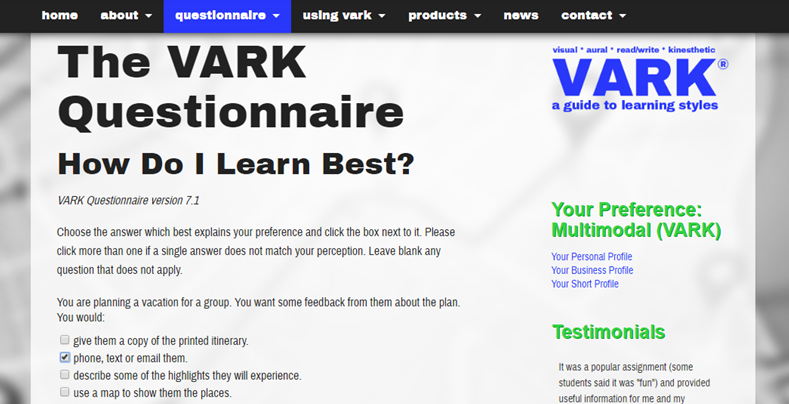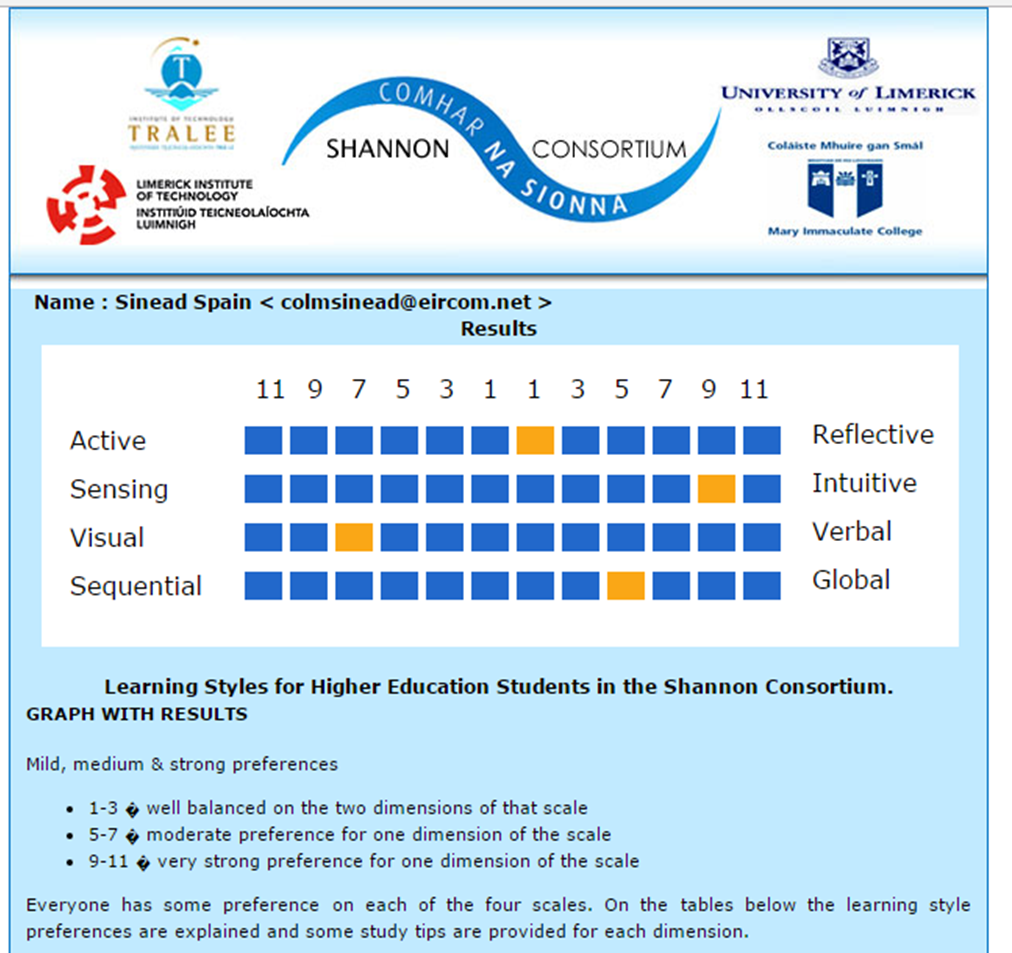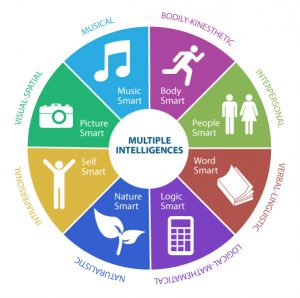Each of us has a specific and unique learning style (sometimes called “preference”) and often we learn best when information is presented to us in this style. Knowing your learning style and being able to use it to your advantage is a great tool for any student. Reflecting on and understanding the way you learn can help you study more effectively while developing strategies that will enhance your learning potential.
The following questionnaires can help you discover and assess your own learning style/styles:
Specifically, these tests will guide you in the discovery of your learning style and will help you maximize your study time based on your type. Once completed, you can use the information gathered from the questionnaires to develop your best strategies and practices to study both inside and outside the class.
Upon completion of this task you will be able to:
- Have a better understanding of your strengths, weaknesses, and habits in order to maximize your learning potential
- Expand your existing learning and studying strategies
- Develop your own methods/strategies for learning effectively while reducing stress
Technology required
- Any mobile device (smartphone, tablet computer) and/or laptop computer, desktop.
- Internet connection is required.
The VARK questionnaire
The VARK acronym stands for:
- Visual images – you prefer learning material in a pictorial or graphic format
- Aural messages or the spoken word – you like to listen to lectures and discuss your work
- Reading and making notes – you learn best through reading and writing
- Kinaesthetic or active learning – you prefer to learn through practical activities
This questionnaire will tell you if you are a visual, auditory, reading/writing, or kinesthetic learner. Some learners may show a strong preference for one of these ways of learning, while others use a combination of learning styles.
Procedure
- Click on this link: ‘How do I learn best’.
- Select the answer or answers which best explains your preference by checking the box next to the response.

- The results page offers a link to the description of your learning style. Take some time to reflect upon your results. You can also save the test to your hard disk as a permanent record.
The Shannon Consortium Learning Styles Questionnaire
This questionnaire was developed by the Shannon Consortium (University of Limerick, Mary Immaculate College, Limerick, Limerick Institute of Technology, and Tralee Institute of Technology). The questionnaire is based on the Felder-Soloman ILS and comprises of 44 short questions.
This questionnaire will help you to:
- Indicate how you learn best
- Design an effective study method that works best for you
- Assist schools and colleges to enhance teaching and learning in the region
Procedure:
- Access the questionnaire through the https://shannonconsortium.ie/ website.
- You can submit as many personal details as you wish, if you do not wish to supply any details, choose the ‘guest’ option.
- Complete the questionnaire by selecting the answer that most applies to you.
- The results will indicate what type of learning style applies to you and offers an overview of the learning style and study tips for each style.

The multiple intelligence self-assessment
The multiple intelligence questionnaire refers to the multiple intelligence theory originally proposed by Gardner in 1983 (Fig. 1). This questionnaire suggests the type of intelligence a person has while defining her/his attitudes and characteristics. A strong score will be 30+ and a weak score will be under 20.

Fig. 1 Gardner’s theory of multiple intelligence (visual representation)
Procedure
- Access the Edutopia Multiple Intelligences Self-Assessment questionnaire (or any of the above questionnaires).
- This questionnaire will tell you how high you score on 8 different learning styles: linguistic, logical-mathematical, visual-spatial, intrapersonal, interpersonal, musical, bodily-kinesthetic, and naturalistic.
- Once completed, take your time to discuss and reflect upon your results. In addition, you can save the test to your hard disk as a permanent record.
Gardner’s multiple intelligence theory:
Other Links
Each of us has a specific and unique learning style (sometimes called “preference”) and often we learn best when information is presented to us in this style. Knowing your learning style and being able to use it to your advantage is a great tool for any student. Reflecting on and understanding the way you learn can help you study more effectively while developing strategies that will enhance your learning potential.The following questionnaires can help you discover and assess your own learning style/styles:<li><a href=”https://vark-learn.com/” target=”_blank” rel=”noopener noreferrer” data-mce-href=”https://vark-learn.com/”><strong>VARK</strong></a></li><li><a href=”http://www.edutopia.org/multiple-intelligences-assessment” target=”_blank” rel=”noopener noreferrer” data-mce-href=”http://www.edutopia.org/multiple-intelligences-assessment”><strong>Multiple Intelligence Self Assessment </strong></a></li>
Specifically, these tests will guide you in the discovery of your learning style and will help you maximize your study time based on your type. Once completed, you can use the information gathered from the questionnaires to develop your best strategies and practices to study both inside and outside the class.Upon completion of this task you will be able to:<li>Have a better understanding of your strengths, weaknesses, and habits in order to maximize your learning potential</li><li>Expand your existing learning and studying strategies</li><li>Develop your own methods/strategies for learning effectively while reducing stress</li>
<strong>Technology required </strong><li>Any mobile device (smartphone, tablet computer) and/or laptop computer, desktop.</li><li>Internet connection is required.</li>
<br /><a href=”https://vark-learn.com/” target=”_blank” rel=”noopener noreferrer” data-mce-href=”https://vark-learn.com/”><strong>The VARK questionnaire</strong></a>The VARK acronym stands for:<li><strong>Visual images</strong> – you prefer learning material in a pictorial or graphic format</li><li><strong>Aural messages or the spoken word</strong> – you like to listen to lectures and discuss your work</li><li><strong>Reading and making notes</strong> – you learn best through reading and writing</li><li><strong>Kinaesthetic or active learning</strong> – you prefer to learn through practical activities</li>
This questionnaire will tell you if you are a visual, auditory, reading/writing, or kinesthetic learner. Some learners may show a strong preference for one of these ways of learning, while others use a combination of learning styles.<b>Procedure</b><li>Click on this link: <a href=”http://vark-learn.com/the-vark-questionnaire/?p=questionnaire” target=”_blank” rel=”noopener noreferrer” data-mce-href=”http://vark-learn.com/the-vark-questionnaire/?p=questionnaire”>’How do I learn best'</a>.</li><li>Select the answer or answers which best explains your preference by checking the box next to the response.<img class=”wp-image-3134 alignnone” src=”https://www.digilanguages.ie/wp-content/uploads/2016/09/VARK-Q.png” alt=”vark-q” width=”532″ height=”272″ data-mce-src=”https://www.digilanguages.ie/wp-content/uploads/2016/09/VARK-Q.png” /></li><li>The results page offers a link to the description of your learning style. Take some time to reflect upon your results. You can also save the test to your hard disk as a permanent record.</li>
<a href=”https://shannonconsortium.ie/” target=”_blank” rel=”noopener noreferrer” data-mce-href=”https://shannonconsortium.ie/”><strong>The Shannon Consortium Learning Styles Questionnaire</strong></a>This questionnaire was developed by the Shannon Consortium (University of Limerick, Mary Immaculate College, Limerick, Limerick Institute of Technology, and Tralee Institute of Technology). The questionnaire is based on the Felder-Soloman ILS and comprises of 44 short questions.This questionnaire will help you to:<li>Indicate how you learn best</li><li>Design an effective study method that works best for you</li><li>Assist schools and colleges to enhance teaching and learning in the region</li>
<strong>Procedure:</strong><li>Access the questionnaire through the https://shannonconsortium.ie/ website.</li><li>You can submit as many personal details as you wish, if you do not wish to supply any details, choose the ‘guest’ option.</li><li>Complete the questionnaire by selecting the answer that most applies to you.</li><li>The results will indicate what type of learning style applies to you and offers an overview of the learning style and study tips for each style.</li>
<img class=”wp-image-3135 alignnone” src=”https://www.digilanguages.ie/wp-content/uploads/2016/09/Shannon-Cons.png” alt=”shannon-consortium questionnaire” width=”373″ height=”350″ data-mce-src=”https://www.digilanguages.ie/wp-content/uploads/2016/09/Shannon-Cons.png” /><strong><a href=”http://www.edutopia.org/multiple-intelligences-assessment” target=”_blank” rel=”noopener noreferrer” data-mce-href=”http://www.edutopia.org/multiple-intelligences-assessment”>The multiple intelligence self-assessment</a></strong>The multiple intelligence questionnaire refers to the multiple intelligence theory originally proposed by Gardner in 1983 (Fig. 1). This questionnaire suggests the type of intelligence a person has while defining her/his attitudes and characteristics. A strong score will be 30+ and a weak score will be under 20.
<strong><img class=”alignnone wp-image-1261″ src=”https://www.digilanguages.ie/wp-content/uploads/2016/09/multiple-intelligences-learning-styles-300×298.jpg” alt=”multiple-intelligences-learning-styles” width=”332″ height=”330″ data-mce-src=”https://www.digilanguages.ie/wp-content/uploads/2016/09/multiple-intelligences-learning-styles-300×298.jpg” /></strong>Fig. 1 Gardner’s theory of multiple intelligence (visual representation)<br /><b>Procedure</b><li>Access the <a href=”https://www.edutopia.org/multiple-intelligences-assessment” target=”_blank” rel=”noopener noreferrer” data-mce-href=”https://www.edutopia.org/multiple-intelligences-assessment”>Edutopia Multiple Intelligences Self-Assessment questionnaire</a> (or any of the above questionnaires).</li><li>This questionnaire will tell you how high you score on 8 different learning styles: linguistic, logical-mathematical, visual-spatial, intrapersonal, interpersonal, musical, bodily-kinesthetic, and naturalistic.</li><li>Once completed, take your time to discuss and reflect upon your results. In addition, you can save the test to your hard disk as a permanent record.</li>
Gardner’s multiple intelligence theory:.<br /><strong>Other Links</strong><li><a href=”http://www.engr.ncsu.edu/learningstyles/ilsweb.html” target=”_blank” rel=”noopener noreferrer” data-mce-href=”http://www.engr.ncsu.edu/learningstyles/ilsweb.html”>Index of Learning Styles Questionnaire (NC State University)</a></li>
Each of us has a specific and unique learning style (sometimes called “preference”) and often we learn best when information is presented to us in this style. Knowing your learning style and being able to use it to your advantage is a great tool for any student. Reflecting on and understanding the way you learn can help you study more effectively while developing strategies that will enhance your learning potential.The following questionnaires can help you discover and assess your own learning style/styles:<li><a href=”https://vark-learn.com/” target=”_blank” rel=”noopener noreferrer” data-mce-href=”https://vark-learn.com/”><strong>VARK</strong></a></li><li><a href=”http://www.edutopia.org/multiple-intelligences-assessment” target=”_blank” rel=”noopener noreferrer” data-mce-href=”http://www.edutopia.org/multiple-intelligences-assessment”><strong>Multiple Intelligence Self Assessment </strong></a></li>
Specifically, these tests will guide you in the discovery of your learning style and will help you maximize your study time based on your type. Once completed, you can use the information gathered from the questionnaires to develop your best strategies and practices to study both inside and outside the class.Upon completion of this task you will be able to:<li>Have a better understanding of your strengths, weaknesses, and habits in order to maximize your learning potential</li><li>Expand your existing learning and studying strategies</li><li>Develop your own methods/strategies for learning effectively while reducing stress</li>
<strong>Technology required </strong><li>Any mobile device (smartphone, tablet computer) and/or laptop computer, desktop.</li><li>Internet connection is required.</li>
<br /><a href=”https://vark-learn.com/” target=”_blank” rel=”noopener noreferrer” data-mce-href=”https://vark-learn.com/”><strong>The VARK questionnaire</strong></a>The VARK acronym stands for:<li><strong>Visual images</strong> – you prefer learning material in a pictorial or graphic format</li><li><strong>Aural messages or the spoken word</strong> – you like to listen to lectures and discuss your work</li><li><strong>Reading and making notes</strong> – you learn best through reading and writing</li><li><strong>Kinaesthetic or active learning</strong> – you prefer to learn through practical activities</li>
This questionnaire will tell you if you are a visual, auditory, reading/writing, or kinesthetic learner. Some learners may show a strong preference for one of these ways of learning, while others use a combination of learning styles.<b>Procedure</b><li>Click on this link: <a href=”http://vark-learn.com/the-vark-questionnaire/?p=questionnaire” target=”_blank” rel=”noopener noreferrer” data-mce-href=”http://vark-learn.com/the-vark-questionnaire/?p=questionnaire”>’How do I learn best'</a>.</li><li>Select the answer or answers which best explains your preference by checking the box next to the response.<img class=”wp-image-3134 alignnone” src=”https://www.digilanguages.ie/wp-content/uploads/2016/09/VARK-Q.png” alt=”vark-q” width=”532″ height=”272″ data-mce-src=”https://www.digilanguages.ie/wp-content/uploads/2016/09/VARK-Q.png” /></li><li>The results page offers a link to the description of your learning style. Take some time to reflect upon your results. You can also save the test to your hard disk as a permanent record.</li>
<a href=”https://shannonconsortium.ie/” target=”_blank” rel=”noopener noreferrer” data-mce-href=”https://shannonconsortium.ie/”><strong>The Shannon Consortium Learning Styles Questionnaire</strong></a>This questionnaire was developed by the Shannon Consortium (University of Limerick, Mary Immaculate College, Limerick, Limerick Institute of Technology, and Tralee Institute of Technology). The questionnaire is based on the Felder-Soloman ILS and comprises of 44 short questions.This questionnaire will help you to:<li>Indicate how you learn best</li><li>Design an effective study method that works best for you</li><li>Assist schools and colleges to enhance teaching and learning in the region</li>
<strong>Procedure:</strong><li>Access the questionnaire through the https://shannonconsortium.ie/ website.</li><li>You can submit as many personal details as you wish, if you do not wish to supply any details, choose the ‘guest’ option.</li><li>Complete the questionnaire by selecting the answer that most applies to you.</li><li>The results will indicate what type of learning style applies to you and offers an overview of the learning style and study tips for each style.</li>
<img class=”wp-image-3135 alignnone” src=”https://www.digilanguages.ie/wp-content/uploads/2016/09/Shannon-Cons.png” alt=”shannon-consortium questionnaire” width=”373″ height=”350″ data-mce-src=”https://www.digilanguages.ie/wp-content/uploads/2016/09/Shannon-Cons.png” /><strong><a href=”http://www.edutopia.org/multiple-intelligences-assessment” target=”_blank” rel=”noopener noreferrer” data-mce-href=”http://www.edutopia.org/multiple-intelligences-assessment”>The multiple intelligence self-assessment</a></strong>The multiple intelligence questionnaire refers to the multiple intelligence theory originally proposed by Gardner in 1983 (Fig. 1). This questionnaire suggests the type of intelligence a person has while defining her/his attitudes and characteristics. A strong score will be 30+ and a weak score will be under 20.
<strong><img class=”alignnone wp-image-1261″ src=”https://www.digilanguages.ie/wp-content/uploads/2016/09/multiple-intelligences-learning-styles-300×298.jpg” alt=”multiple-intelligences-learning-styles” width=”332″ height=”330″ data-mce-src=”https://www.digilanguages.ie/wp-content/uploads/2016/09/multiple-intelligences-learning-styles-300×298.jpg” /></strong>Fig. 1 Gardner’s theory of multiple intelligence (visual representation)<br /><b>Procedure</b><li>Access the <a href=”https://www.edutopia.org/multiple-intelligences-assessment” target=”_blank” rel=”noopener noreferrer” data-mce-href=”https://www.edutopia.org/multiple-intelligences-assessment”>Edutopia Multiple Intelligences Self-Assessment questionnaire</a> (or any of the above questionnaires).</li><li>This questionnaire will tell you how high you score on 8 different learning styles: linguistic, logical-mathematical, visual-spatial, intrapersonal, interpersonal, musical, bodily-kinesthetic, and naturalistic.</li><li>Once completed, take your time to discuss and reflect upon your results. In addition, you can save the test to your hard disk as a permanent record.</li>
Gardner’s multiple intelligence theory:.<br /><strong>Other Links</strong><li><a href=”http://www.engr.ncsu.edu/learningstyles/ilsweb.html” target=”_blank” rel=”noopener noreferrer” data-mce-href=”http://www.engr.ncsu.edu/learningstyles/ilsweb.html”>Index of Learning Styles Questionnaire (NC State University)</a></li>
Each of us has a specific and unique learning style (sometimes called “preference”) and often we learn best when information is presented to us in this style. Knowing your learning style and being able to use it to your advantage is a great tool for any student. Reflecting on and understanding the way you learn can help you study more effectively while developing strategies that will enhance your learning potential.The following questionnaires can help you discover and assess your own learning style/styles:<li><a href=”https://vark-learn.com/” target=”_blank” rel=”noopener noreferrer” data-mce-href=”https://vark-learn.com/”><strong>VARK</strong></a></li><li><a href=”http://www.edutopia.org/multiple-intelligences-assessment” target=”_blank” rel=”noopener noreferrer” data-mce-href=”http://www.edutopia.org/multiple-intelligences-assessment”><strong>Multiple Intelligence Self Assessment </strong></a></li>
Specifically, these tests will guide you in the discovery of your learning style and will help you maximize your study time based on your type. Once completed, you can use the information gathered from the questionnaires to develop your best strategies and practices to study both inside and outside the class.Upon completion of this task you will be able to:<li>Have a better understanding of your strengths, weaknesses, and habits in order to maximize your learning potential</li><li>Expand your existing learning and studying strategies</li><li>Develop your own methods/strategies for learning effectively while reducing stress</li>
<strong>Technology required </strong><li>Any mobile device (smartphone, tablet computer) and/or laptop computer, desktop.</li><li>Internet connection is required.</li>
<br /><a href=”https://vark-learn.com/” target=”_blank” rel=”noopener noreferrer” data-mce-href=”https://vark-learn.com/”><strong>The VARK questionnaire</strong></a>The VARK acronym stands for:<li><strong>Visual images</strong> – you prefer learning material in a pictorial or graphic format</li><li><strong>Aural messages or the spoken word</strong> – you like to listen to lectures and discuss your work</li><li><strong>Reading and making notes</strong> – you learn best through reading and writing</li><li><strong>Kinaesthetic or active learning</strong> – you prefer to learn through practical activities</li>
This questionnaire will tell you if you are a visual, auditory, reading/writing, or kinesthetic learner. Some learners may show a strong preference for one of these ways of learning, while others use a combination of learning styles.<b>Procedure</b><li>Click on this link: <a href=”http://vark-learn.com/the-vark-questionnaire/?p=questionnaire” target=”_blank” rel=”noopener noreferrer” data-mce-href=”http://vark-learn.com/the-vark-questionnaire/?p=questionnaire”>’How do I learn best'</a>.</li><li>Select the answer or answers which best explains your preference by checking the box next to the response.<img class=”wp-image-3134 alignnone” src=”https://www.digilanguages.ie/wp-content/uploads/2016/09/VARK-Q.png” alt=”vark-q” width=”532″ height=”272″ data-mce-src=”https://www.digilanguages.ie/wp-content/uploads/2016/09/VARK-Q.png” /></li><li>The results page offers a link to the description of your learning style. Take some time to reflect upon your results. You can also save the test to your hard disk as a permanent record.</li>
<a href=”https://shannonconsortium.ie/” target=”_blank” rel=”noopener noreferrer” data-mce-href=”https://shannonconsortium.ie/”><strong>The Shannon Consortium Learning Styles Questionnaire</strong></a>This questionnaire was developed by the Shannon Consortium (University of Limerick, Mary Immaculate College, Limerick, Limerick Institute of Technology, and Tralee Institute of Technology). The questionnaire is based on the Felder-Soloman ILS and comprises of 44 short questions.This questionnaire will help you to:<li>Indicate how you learn best</li><li>Design an effective study method that works best for you</li><li>Assist schools and colleges to enhance teaching and learning in the region</li>
<strong>Procedure:</strong><li>Access the questionnaire through the https://shannonconsortium.ie/ website.</li><li>You can submit as many personal details as you wish, if you do not wish to supply any details, choose the ‘guest’ option.</li><li>Complete the questionnaire by selecting the answer that most applies to you.</li><li>The results will indicate what type of learning style applies to you and offers an overview of the learning style and study tips for each style.</li>
<img class=”wp-image-3135 alignnone” src=”https://www.digilanguages.ie/wp-content/uploads/2016/09/Shannon-Cons.png” alt=”shannon-consortium questionnaire” width=”373″ height=”350″ data-mce-src=”https://www.digilanguages.ie/wp-content/uploads/2016/09/Shannon-Cons.png” /><strong><a href=”http://www.edutopia.org/multiple-intelligences-assessment” target=”_blank” rel=”noopener noreferrer” data-mce-href=”http://www.edutopia.org/multiple-intelligences-assessment”>The multiple intelligence self-assessment</a></strong>The multiple intelligence questionnaire refers to the multiple intelligence theory originally proposed by Gardner in 1983 (Fig. 1). This questionnaire suggests the type of intelligence a person has while defining her/his attitudes and characteristics. A strong score will be 30+ and a weak score will be under 20.
<strong><img class=”alignnone wp-image-1261″ src=”https://www.digilanguages.ie/wp-content/uploads/2016/09/multiple-intelligences-learning-styles-300×298.jpg” alt=”multiple-intelligences-learning-styles” width=”332″ height=”330″ data-mce-src=”https://www.digilanguages.ie/wp-content/uploads/2016/09/multiple-intelligences-learning-styles-300×298.jpg” /></strong>Fig. 1 Gardner’s theory of multiple intelligence (visual representation)<br /><b>Procedure</b><li>Access the <a href=”https://www.edutopia.org/multiple-intelligences-assessment” target=”_blank” rel=”noopener noreferrer” data-mce-href=”https://www.edutopia.org/multiple-intelligences-assessment”>Edutopia Multiple Intelligences Self-Assessment questionnaire</a> (or any of the above questionnaires).</li><li>This questionnaire will tell you how high you score on 8 different learning styles: linguistic, logical-mathematical, visual-spatial, intrapersonal, interpersonal, musical, bodily-kinesthetic, and naturalistic.</li><li>Once completed, take your time to discuss and reflect upon your results. In addition, you can save the test to your hard disk as a permanent record.</li>
Gardner’s multiple intelligence theory:.<br /><strong>Other Links</strong><li><a href=”http://www.engr.ncsu.edu/learningstyles/ilsweb.html” target=”_blank” rel=”noopener noreferrer” data-mce-href=”http://www.engr.ncsu.edu/learningstyles/ilsweb.html”>Index of Learning Styles Questionnaire (NC State University)</a></li>

